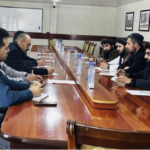An average of nine children were killed or maimed on a daily basis in the first nine months of this year in “the world’s most lethal warzone” of Afghanistan, according to a UNECIF report released on Tuesday.
The rate of casualties of children is 11 percent up compared to the same period in 2018, said the report titled, “Preserving Hope in Afghanistan: Protecting children in the world’s most lethal conflict”.
The UNECIF report blames all warring parties for the “devastating impact” on children due to the conflict that has dragged on for 40 years now.
“In the first three quarters of 2019, 631 children have been killed, and 1,830 injured. The numbers are shocking. We call on all parties to the conflict to fulfill their responsibility under international norms to shield children of the consequences of war,” UNECIF Country Representative Aboubacar Kampo told journalists at the launch of the report.
The shocking levels of violence were mainly attributed to a surge in suicide bombings and ground engagements between pro and anti-government forces.
Overall, the conflict has killed nearly 6,500 children and wounded almost 15,000 others between 2009 and 2018, making Afghanistan “currently the world’s worst killing field”.
UNECIF spokesperson Alison Parker told Efe news that the agency wanted to draw the world attention to the fact that Afghanistan “is one of the most dangerous countries on the planet for children”.
In 2018, the UN verified 162 attacks against schools, hospitals, and their staff.
It also recorded 44 incidents in which humanitarian aid could not be delivered to needy communities, mainly due to the active war, in a country where an estimated 55 percent of the population lives below the poverty line by 2016, compared to 34 percent in 2007 and 2008.
The UN agency is currently providing treatment to 277,000 severely-malnourished Afghan children.
It was also increasingly working to help some of the 2.8 million people affected by a severe drought in 2018 in a country where only 64 percent of the population has access to safe drinking water free from outside contamination.











